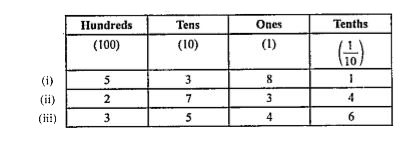Make 5 more examples of problems given in 1 and 2 and solve them with your friends.Add with the help of '1/6 + 1/6'Solution in Punjabi
Step by step video & image solution for Make 5 more examples of problems given in 1 and 2 and solve them with your friends.Add with the help of '1/6 + 1/6' by Maths experts to help you in doubts & scoring excellent marks in Class 6 exams.
Topper's Solved these Questions
- BOOK - NAND LAL PUBLICATIONCHAPTER - FRACTIONSEXERCISE - TRY THESE (PAGE-157)4videos
FRACTIONS
- BOOK - NAND LAL PUBLICATIONCHAPTER - FRACTIONSEXERCISE - TRY THESE (PAGE-159)2videos
FRACTIONS
- BOOK - NAND LAL PUBLICATIONCHAPTER - FRACTIONSEXERCISE - TRY THESE (PAGE-155)3videos
FRACTIONS
- BOOK - NAND LAL PUBLICATIONCHAPTER - DECIMALSEXERCISE - TRY THESE13videos
DECIMALS
- BOOK - NAND LAL PUBLICATIONCHAPTER - KNOWING OUR NUMBERSEXERCISE - SAMPLE PAPER FOR PRACTICE19videos
KNOWING OUR NUMBERS
Similar Questions
Find the difference between 7/8 and 3/8.
07:43View SolutionAdd 25and37.
05:58View SolutionMy mother dividied an apple into 4 equal parts.Se gave me 2 parts and my brother one part.How much apple did she give to both of us?
02:51View SolutionCan you write the following as decimals?
 12:40View Solution
12:40View SolutionWrite the expressions for the statements given below
Divide the difference of 14 and 6 by 2.05:35View SolutionThe probabilities of A, B and C solving a problem independently are respectively 14, 15, 16. If 21 such problems are given to A, B and C then the probability that at least 11 problems can be solved by them is
04:32View SolutionA problem is given to three students whose chances of solving it are 1/4, 1/5 and 1/6 respectively. Find the probability that the problem is solved.
04:02View SolutionThe probabilites of A , B and C of solving a problem are 16,15 and 13 respectively , What is the probability that the problem is solved ?
05:06View SolutionThe probabilities of A, B and C solving a problem independently are respectively 14, 15, 16. If 21 such problems are given to A, B and C then the probability that at least 11 problems can be solved by them is
01:18View SolutionA problem is given to three students whose chances of solving it are 1/4, 1/5 and 1/6 respectively. What is the probability that the problem will be solved?
01:05View SolutionA problem is given to three children, whose chances of solving it are 16, '1/4' and 1/5, what is the probability that : At least one of them may solve. it.
01:11View SolutionA problem is given to three children, whose chances of solving it are 13, 1/5 and 1/6, what is the probability that : At least one of them may solve. it.
01:10View SolutionA problem is given to three children, whose chances of solving it are 13, 1/5 and 1/6, what is the probability that : Only one of them solves it correctly
03:11View Solutionचित्र की सहायता से जोड़िए- 13+13
02:28View Solutionचित्र की सहायता से जोड़िए- 19+19
02:48View Solutionचित्र की सहायता से जोड़िए- 16+16
09:00View Solution
